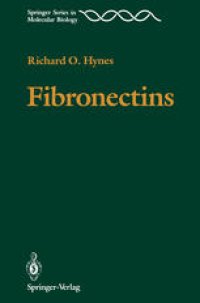
Ebook: Fibronectins
Author: Richard O. Hynes (auth.)
- Tags: Life Sciences general, Cell Biology, Biochemistry general, Allergology, Immunology
- Series: Springer Series in Molecular Biology
- Year: 1990
- Publisher: Springer-Verlag New York
- Edition: 1
- Language: English
- pdf
Fibronectins comprise a class of high molecular weight glycoproteins present both in extracellular matrices and in soluble form in body fluids. Although they have been studied for about forty years, their real significance emerged only during the past decade. Intensive research has focused on their role in platelet function, cell migration, the cytoskeleton, reticuloendothelial function, and on alterations in fibronectin distribution during development and disease. Fibronectins have emerged as glycoproteins with a very interesting set of properties generally involving adhesion of cells to cells or to extracellular material. In more recent years, the complete sequences of several fibronectin molecules and their genes were determined, the relation between structure and function was understood and much has been learned about cell surface receptors for fibronectins and other adhesive ligands. Having been at the forefront of all these exciting developments, the author has synthesized the entire field and with all the latest information at hand for the first time given it a clear perspective.
Fibronectins comprise a class of high molecular weight glycoproteins present both in extracellular matrices and in soluble form in body fluids. Although they have been studied for about forty years, their real significance emerged only during the past decade. Intensive research has focused on their role in platelet function, cell migration, the cytoskeleton, reticuloendothelial function, and on alterations in fibronectin distribution during development and disease. Fibronectins have emerged as glycoproteins with a very interesting set of properties generally involving adhesion of cells to cells or to extracellular material. In more recent years, the complete sequences of several fibronectin molecules and their genes were determined, the relation between structure and function was understood and much has been learned about cell surface receptors for fibronectins and other adhesive ligands. Having been at the forefront of all these exciting developments, the author has synthesized the entire field and with all the latest information at hand for the first time given it a clear perspective.
Fibronectins comprise a class of high molecular weight glycoproteins present both in extracellular matrices and in soluble form in body fluids. Although they have been studied for about forty years, their real significance emerged only during the past decade. Intensive research has focused on their role in platelet function, cell migration, the cytoskeleton, reticuloendothelial function, and on alterations in fibronectin distribution during development and disease. Fibronectins have emerged as glycoproteins with a very interesting set of properties generally involving adhesion of cells to cells or to extracellular material. In more recent years, the complete sequences of several fibronectin molecules and their genes were determined, the relation between structure and function was understood and much has been learned about cell surface receptors for fibronectins and other adhesive ligands. Having been at the forefront of all these exciting developments, the author has synthesized the entire field and with all the latest information at hand for the first time given it a clear perspective.
Content:
Front Matter....Pages i-xv
Introduction and Historical Overview....Pages 1-6
Methods for Identification of Fibronectins....Pages 7-23
Distribution of Fibronectins in Vivo ....Pages 24-48
Expression of Fibronectins by Cells in Culture....Pages 49-83
Interactions of Fibronectins....Pages 84-112
Structure of Fibronectins....Pages 113-175
Biosynthesis and Fibrillogenesis....Pages 176-199
Cellular Adhesion and Cell Surface Receptors....Pages 200-230
Fibronectin and the Cytoskeleton....Pages 231-248
Fibronectin and the Cytoskeleton....Pages 249-280
Development and Differentiation....Pages 281-300
Oncogenic Transformation....Pages 301-334
Hemostasis and Thrombosis....Pages 335-348
Wound Healing, Inflammation, and Fibrosis....Pages 349-364
Phagocytosis and Interactions with Pathogenic Microorganisms....Pages 365-379
Implications for Future Research....Pages 380-392
Back Matter....Pages 393-546
Fibronectins comprise a class of high molecular weight glycoproteins present both in extracellular matrices and in soluble form in body fluids. Although they have been studied for about forty years, their real significance emerged only during the past decade. Intensive research has focused on their role in platelet function, cell migration, the cytoskeleton, reticuloendothelial function, and on alterations in fibronectin distribution during development and disease. Fibronectins have emerged as glycoproteins with a very interesting set of properties generally involving adhesion of cells to cells or to extracellular material. In more recent years, the complete sequences of several fibronectin molecules and their genes were determined, the relation between structure and function was understood and much has been learned about cell surface receptors for fibronectins and other adhesive ligands. Having been at the forefront of all these exciting developments, the author has synthesized the entire field and with all the latest information at hand for the first time given it a clear perspective.
Content:
Front Matter....Pages i-xv
Introduction and Historical Overview....Pages 1-6
Methods for Identification of Fibronectins....Pages 7-23
Distribution of Fibronectins in Vivo ....Pages 24-48
Expression of Fibronectins by Cells in Culture....Pages 49-83
Interactions of Fibronectins....Pages 84-112
Structure of Fibronectins....Pages 113-175
Biosynthesis and Fibrillogenesis....Pages 176-199
Cellular Adhesion and Cell Surface Receptors....Pages 200-230
Fibronectin and the Cytoskeleton....Pages 231-248
Fibronectin and the Cytoskeleton....Pages 249-280
Development and Differentiation....Pages 281-300
Oncogenic Transformation....Pages 301-334
Hemostasis and Thrombosis....Pages 335-348
Wound Healing, Inflammation, and Fibrosis....Pages 349-364
Phagocytosis and Interactions with Pathogenic Microorganisms....Pages 365-379
Implications for Future Research....Pages 380-392
Back Matter....Pages 393-546
....